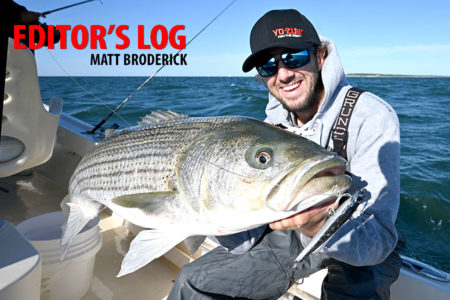Results of the preliminary stock assessment have fishery managers looking for answers to help rebuild the striped bass fishery.
VIRGINIA VOTES TO CLOSE TROPHY STRIPER SEASON
On April 23, the Virginia Marine Resources Commission voted unanimously (7-0) to enact an emergency closure for the spring recreational striped bass trophy season. Virginia’s decision comes following the recent scientific assessment of striped bass that shows the striped bass population has been below the sustainable threshold for the past six years and overfishing has been occurring since 2010.
“Virginia has always been a conservation leader, and this is a time to step up. The recent stock assessment shows that early action is needed to slow the decline and restore this fishery to sustainable levels,” Virginia Marine Resources Commissioner Steven G. Bowman said. “I am proud of the swift action taken by the Commission.” The emergency measure will eliminate the spring striped bass trophy season in the Bay from May 1 through June 15, the Coast from May 1 through May 15, and the Virginia tributaries to the Potomac River from April 29 through May 15. Starting May 16 through June 15 fishermen will be able to catch and keep two striped bass from 20 to 28 inches.
“There has to be a starting point for conservation,” Commissioner Bowman said, while adding “However, we cannot act alone. We also need swift and lasting conservation measures enacted by the Atlantic States Marine Fisheries Commission (ASMFC).”
“ASMFC should incentivize and encourage other states to follow Virginia’s lead and take action this fishing season,” Bowman added.
35-INCH MINIMUM BEING CONSIDERED
In a memorandum from the ASMFCs Atlantic Striped Bass Technical Committee (TC) to the Atlantic Striped Bass Management Board (Board) dated April 22, 2019, the TC made their recommendations for the reduction in harvest required to achieve F threshold and F target in 2020, along with examples of the recreational options needed to achieve those reductions. At its February 2019 meeting, the Atlantic Striped Bass Management Board tasked the TC with providing the Board with a report that shows the reductions in harvest needed to reduce F to F threshold (0.24) and F target (0.197) and also providing one example of recreational bag and size limit combination (if necessary, seasonal restrictions) needed to achieve these conditions a) on the coast and b) in the Chesapeake Bay and report back to the Board at its May meeting.
For those speculating on what those measures might be, the TC developed an example management change for the ocean recreational fishery and for the Chesapeake Bay (Bay) recreational fishery that would achieve a 17 percent reduction in total recreational removals (harvest and dead discards) relative to 2017 to reach F target. The TC assumed commercial removals would also be reduced by 17 percent through other management actions, so the reduction in total removals would be enough to bring F to the target. Since the ocean is already at a 1-fish bag limit and fishing seasons vary so much along the coast, the TC only looked at a size limit analysis for the ocean. The TC concluded that in the ocean (which includes ocean waters from Maine to North Carolina and non-Chesapeake Bay inland waters like Delaware Bay and Long Island Sound), the current minimum size limit is 28 inches. In order to reduce total removals by 17 percent, the size limit would need to be increased to 35 inches. This analysis assumed that current non-compliant harvest (harvest of fish smaller than the current size limit) would still occur. As with any increase in minimum size, dead releases would be expected to increase as anglers would have to release fish that were no longer of legal size.
Under the 35-inch size limit, dead releases are expected to increase by 3 percent in the ocean. This increase is more than offset by the reduction in harvested fish. A 17 percent reduction is estimated if Maryland raised the minimum size limit from 19 inches for the summer/fall season to 21 inches. In Virginia, an 18 percent reduction is estimated if the 20-inch minimum size limit is increased to 22 inches. Under these scenarios, dead releases are expected to increase by 4.3 percent for Maryland and 3.5 percent for Virginia, but again, the increase is offset by the reduction in harvest.



